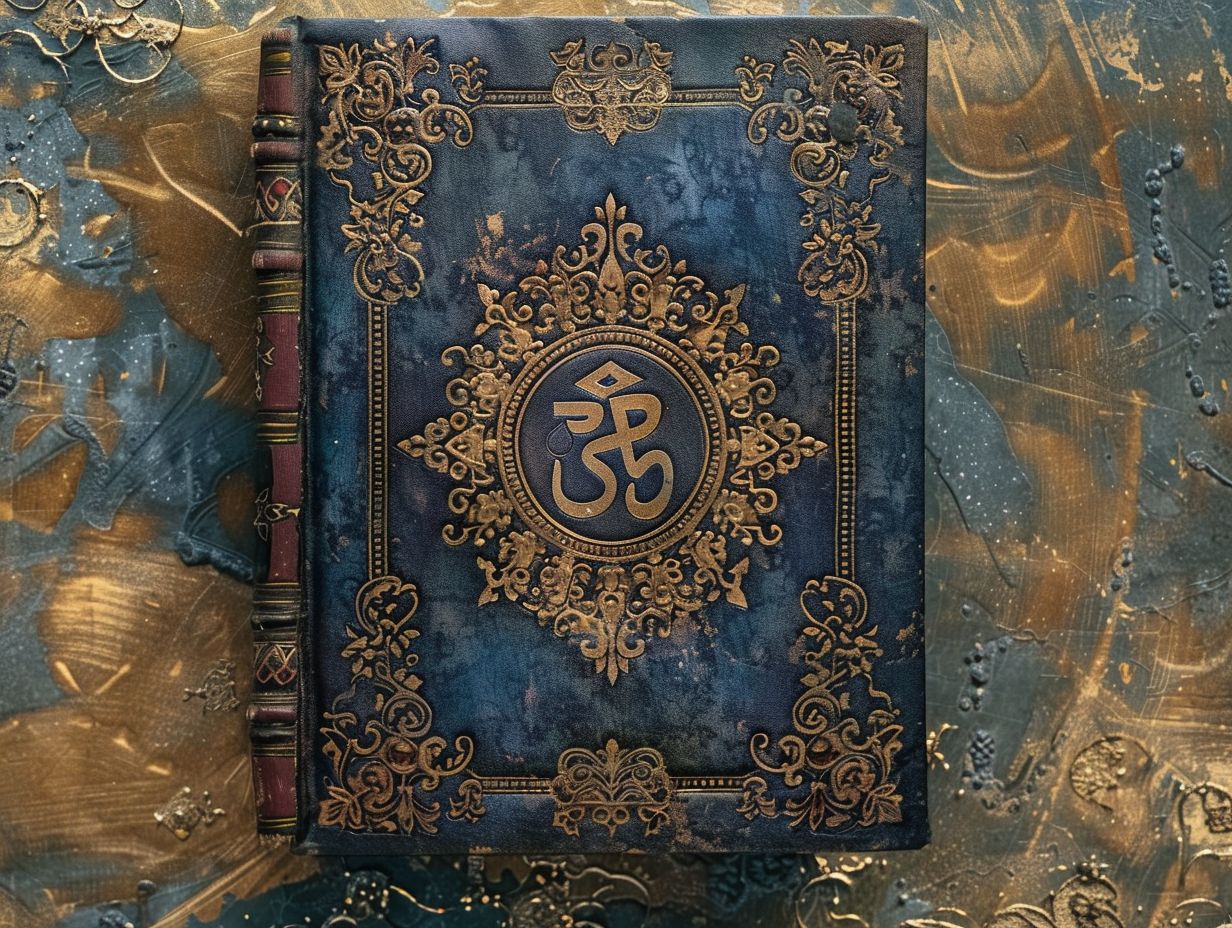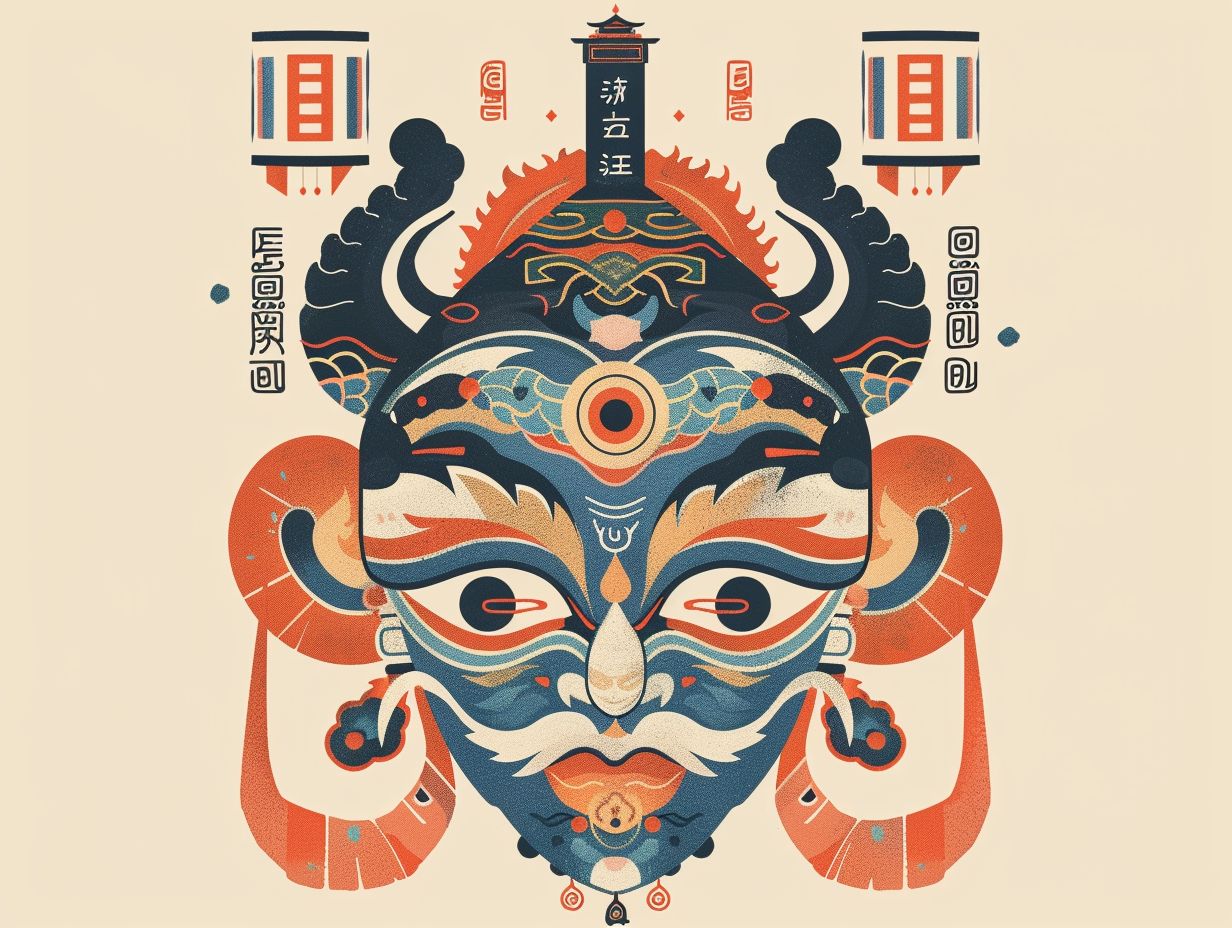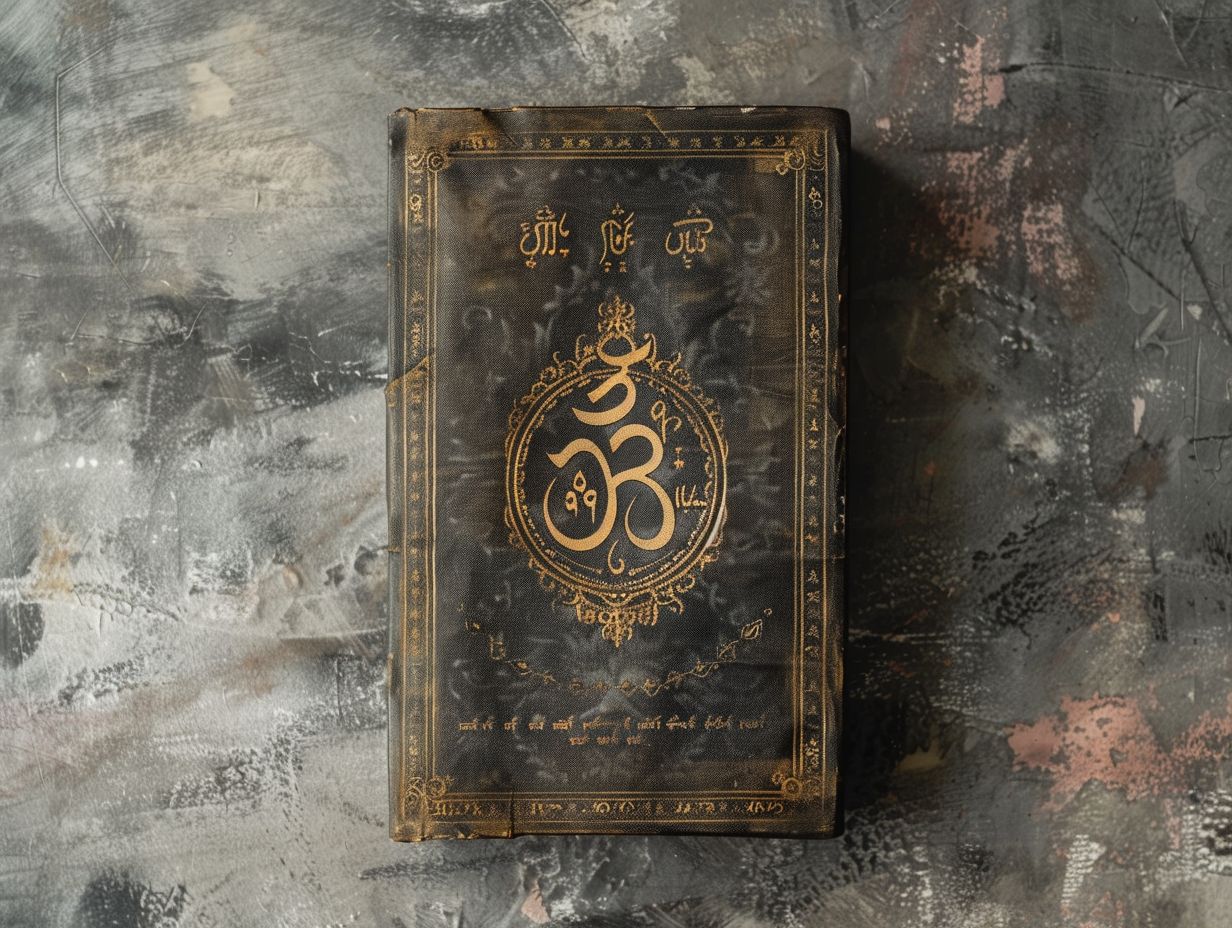An Overview of Brahma Sutra
The Brahma Sutra stands as a cornerstone of Hindu philosophy, offering deep insights into the essence of reality and the self. This seminal text delves into its origins, main teachings, and pivotal concepts such as Brahman, Atman, and Moksha.
Moreover, it investigates the various schools of thought that interpret the Sutra, including Advaita, Dvaita, and Vishishtadvaita. The relevance of the Brahma Sutra in today’s spiritual landscape is significant, as it provides effective approaches for studying this timeless work.
An enlightening journey awaits those who seek to explore the profound depths of this ancient text.
What Is the Brahma Sutra?

The Brahma Sutra stands as a pivotal text within the Vedanta school of Hindu philosophy, serving as a fundamental reference for comprehending the teachings of the Upanishads and the essence of Brahman, the ultimate reality in Hindu thought.
This ancient scripture, attributed to the sage Vedavyasa, delves into essential questions surrounding existence, consciousness, and the quest for liberation, or moksha. Its profound metaphysical insights scrutinize the intricate relationship between Atman (the individual self) and Brahman, underscoring themes of non-duality and the interconnectedness of all existence.
The sutras present a comprehensive framework for philosophical exploration, guiding seekers toward spiritual enlightenment and self-realization.
What Are the Origins of the Brahma Sutra?
The origins of the Brahma Sutra can be traced back to the sage Vedavyasa, who is traditionally credited with its compilation around the 1st century CE, amidst a vibrant landscape of philosophical discourse in ancient India. This seminal work serves as a synthesis of various teachings encapsulated within the Upanishads, offering a structured framework for comprehending the nature of Brahman and the principles of Vedanta.
During this period, India emerged as a crucible of diverse philosophies, where numerous spiritual traditions competed for adherents and stimulated intellectual inquiry. The Vedas, regarded as the oldest sacred texts, established a foundational spiritual framework that significantly shaped both ethical and metaphysical inquiries of the era. As scholars engaged in rigorous debates over vital concepts related to the self, the universe, and ultimate reality, the necessity for a coherent philosophical system became increasingly clear a gap that the Brahma Sutra aimed to fill.
By weaving together these intricate ideas, the text not only addressed profound theological questions but also illuminated insights into the human condition and the pursuit of liberation, reflecting a society deeply invested in spiritual awakening and enlightenment.
What Are the Main Teachings of the Brahma Sutra?
The Brahma Sutra articulates a series of profound teachings centered on the concept of Brahman as the ultimate reality and the essence of all existence. Among its fundamental doctrines is the principle of non-duality, which asserts that the individual self (Atman) and the universal spirit (Brahman) are intrinsically unified. This insight guides seekers toward self-realization and liberation (moksha) through deep philosophical inquiry and meditation.
These teachings underscore the significance of recognizing the interconnectedness of all beings and the universe, urging practitioners to rise above the illusion of separateness. By looking into the nature of reality, the aspirant fosters an awareness that nurtures compassion and ethical living. Through engaging in practices such as selfless service, devotion, and disciplined study, individuals can align their lives with these profound philosophical insights.
Furthermore, the Sutras explore meditation as an essential instrument for attaining inner peace and clarity, ultimately illuminating the path toward liberation and the realization of one’s true nature. This holistic approach not only shapes individual spiritual journeys but also enriches the broader social fabric by fostering harmony and unity.
What Are the Key Concepts of the Brahma Sutra?
At the heart of the Brahma Sutra lie several pivotal concepts that illuminate the nature of reality and the human experience. Among these are Brahman, the ultimate cosmic principle, and Atman, the individual self.
The Sutra also delves into the profound notion of non-duality, which posits that Brahman and Atman are fundamentally one and the same. Furthermore, the text examines Maya, or illusion, emphasizing the transient nature of the universe, and Moksha, the ultimate aspiration of liberation from the relentless cycle of birth and death.
What Is Brahman?
In the context of the Brahma Sutra, Brahman is portrayed as the ultimate reality and cosmic principle that underlies all existence, transcending both the physical realm and human perception. This non-dualistic perspective on Brahman asserts that all individual souls (Atman) are but manifestations of this singular divine consciousness, thereby inviting seekers to delve into their own nature in relation to this profound truth.
Within Vedanta philosophy, Brahman is defined by its attributes of sat (existence), chit (consciousness), and ananda (bliss), underscoring the deep interconnectedness of all beings. This concept encourages individuals to recognize that their essence is not distinct from the universe; rather, it is a reflection of the cosmic whole.
Through the contemplation of Brahman, seekers are afforded the opportunity to cultivate a deeper awareness of their position within the infinite tapestry of existence, fostering a sense of unity with the cosmos. Understanding this relationship serves to inspire an awakening to spiritual truths, ultimately leading to liberation from the illusions of separateness and duality.
What Is Atman?
Atman represents the individual self or soul within the context of the Brahma Sutra, regarded as the true essence of a person that transcends mere physical form and personal identity. Understanding Atman is pivotal for realizing one s connection to Brahman, as this realization serves as the cornerstone for achieving self-realization and liberation (moksha) from the cyclical nature of existence.
Exploring the nature of Atman invites individuals to delve into the depths of their consciousness, prompting profound questions about their true identities beyond societal roles and material aspirations. This introspective journey culminates in insights that foster personal transformation, guiding seekers along their spiritual paths towards liberation.
By comprehending that Atman is intrinsically linked to Brahman, practitioners can grasp the fundamental unity that pervades all existence. Engaging with this interconnectedness nurtures a deep sense of oneness with all living beings, thereby reinforcing the significance of empathy and compassion in their quest for enlightenment.
In this context, the pursuit of self-knowledge transforms into a collective endeavor, illuminating the path toward liberation not only for oneself but for others as well.
What Is Maya?

Maya, often interpreted as illusion, embodies the perceptual veil that obscures the true nature of reality within the framework of the Brahma Sutra. This concept illuminates the deceptive characteristics of the material world, which diverts individuals from acknowledging the non-duality of Atman and Brahman, ultimately prompting a profound existential inquiry into the nature of existence.
Through an examination of Maya, one can grasp how human perception is frequently shrouded by an attachment to the physical realm. This exploration raises significant questions about the essence of reality and challenges individuals to transcend mere appearances.
The intricate interplay between illusion and spiritual truth acts as a portal for deeper investigation; as one navigates the distractions of the mind, the essence of their true self gradually unfolds. The Brahma Sutra serves as a guiding light for seekers, helping them discern between transient phenomena and the timeless reality that underlies existence, pointing toward a unified cosmos where individual consciousness seamlessly merges with the greater whole.
What Is Moksha?
Moksha, the ultimate objective of the Brahma Sutra, represents liberation from the relentless cycle of birth and death (samsara) and the profound realization of one s true essence as Atman, in alignment with Brahman. This concept underscores the attainment of spiritual enlightenment through deep self-inquiry and philosophical contemplation, culminating in the experience of ultimate truth and divine consciousness.
The importance of Moksha transcends mere liberation; it embodies a transformative journey that profoundly influences one s approach to ethical living and spiritual practice. Within Hindu philosophy, the path to liberation can be navigated through various means, such as karma, which highlights the significance of righteous actions and their far-reaching consequences. Concurrently, adherence to dharma establishes a framework for ethical living that resonates with the harmony of the universe.
Meditation emerges as an essential instrument in this quest, nurturing inner peace and self-awareness critical aspects for comprehending one s true self. Collectively, these elements form a comprehensive approach to achieving Moksha, emphasizing its pivotal role in both spiritual growth and moral integrity.
What Are the Different Schools of Thought on the Brahma Sutra?
The Brahma Sutra has inspired a rich tapestry of philosophical schools within Hindu thought, notably Advaita, Dvaita, and Vishishtadvaita. Each of these schools offers its own unique interpretation of the text’s profound teachings.
Advaita, established by Adi Shankaracharya, champions the concept of non-dualism, positing the essential oneness of Atman and Brahman. In contrast, Dvaita underscores dualism, drawing a clear distinction between individual souls and the divine.
Meanwhile, Vishishtadvaita introduces a nuanced perspective known as qualified non-dualism, recognizing both the unity and the diversity inherent in the divine reality.
What Is the Advaita School?
Advaita, the esteemed non-dualistic philosophy grounded in the teachings of the Brahma Sutra, was brought into prominence by the philosopher Adi Shankaracharya in the 8th century CE. This profound school of thought asserts that there exists no fundamental distinction between Atman and Brahman, emphasizing that the realization of this identity is vital for attaining spiritual liberation and enlightenment.
At the core of Advaita is the concept of Brahman, which embodies the ultimate, unchanging reality that underpins all existence. Described as formless, infinite, and transcendent, Brahman serves as the source from which all things emerge.
In contrast, Atman signifies the individual self or soul, reflecting the true essence of one’s being. The philosophical dialogue further introduces the notion of Maya, the illusionary force that obscures the true nature of reality, leading individuals to mistakenly identify with the ephemeral world.
Through profound meditation and self-inquiry, practitioners endeavor to penetrate these layers of illusion, cultivating an understanding that transcends duality. In doing so, they connect the principles of Advaita to broader metaphysical discussions and holistic spiritual practices, enriching their spiritual journey.
What Is the Dvaita School?
Dvaita, or dualism, represents a philosophical school founded by Madhvacharya in the 13th century, which offers a contrasting perspective on the Brahma Sutra when compared to Advaita. Dvaita posits that Atman and Brahman are eternally distinct entities, advocating for a devotional approach to spirituality and underscoring the significance of individual souls in relation to the divine.
This interpretation results in a distinctive understanding of the Brahma Sutra, wherein the focus transitions from non-duality to a relationship anchored in devotion and service. For followers of Dvaita, the divine is perceived as an external, personal God, making the practice of bhakti devotional worship a cornerstone of their spiritual lives.
In contrast to the more abstract and impersonal conception of ultimate reality found in Advaita, Dvaita’s dualism cultivates an intimate connection between devotees and the divine. This devotion not only enriches the spiritual journeys of individuals but also markedly influences the wider landscape of Hindu thought, shaping various traditions and practices that celebrate a loving relationship with God.
What Is the Vishishtadvaita School?
Vishishtadvaita, or qualified non-dualism, as articulated by the philosopher Ramanuja in the 11th century, presents a distinctive interpretation of the Brahma Sutra that embraces both unity and diversity within the divine reality. This philosophical school teaches that while Atman and Brahman are fundamentally intertwined, they also possess unique characteristics, underscoring the pivotal role of devotion and grace on the path to liberation.
By introducing the idea that individual souls can cultivate a personal relationship with the divine, Vishishtadvaita profoundly influences the understanding of spiritual practice within Hinduism. The core tenet of this philosophy asserts that the divine essence permeates the universe while simultaneously expressing its diversity. This dual acknowledgment not only resonates with the teachings found in the Brahma Sutra but also elevates the significance of bhakti, or devotion, as a means to attain moksha, or liberation.
Such an interpretation has left a lasting impact on devotional movements throughout India, inspiring adherents to engage deeply with their personal deities while promoting inclusivity within the spiritual experience.
What Are the Relevance and Importance of the Brahma Sutra Today?

The relevance of the Brahma Sutra in contemporary society is profound, as its teachings profoundly shape numerous facets of Hindu philosophy and spiritual practices.
Serving as a foundational text, it offers invaluable insights into the moral and ethical dimensions of life, guiding individuals through existential inquiries and nurturing a deeper comprehension of both the self and the cosmos.
How Does the Brahma Sutra Influence Hindu Philosophy?
The Brahma Sutra exerts a profound influence on Hindu philosophy by offering a systematic framework that articulates intricate concepts such as Brahman, Atman, and the nature of reality. Its teachings promote philosophical inquiry and contemplative practices, nurturing spiritual enlightenment across various wisdom traditions within Hinduism.
By delineating a cohesive understanding of these foundational elements, the Brahma Sutra fosters the emergence of diverse philosophical schools, each interpreting its principles through unique lenses. For instance, schools like Advaita Vedanta emphasize non-duality, highlighting the direct experience of the oneness of Brahman and Atman. The text serves as a cornerstone for many contemporary meditation techniques, guiding practitioners toward self-realization through its profound insights.
Moreover, by informing ethical considerations, the Sutra encourages adherents to align their actions with spiritual truths, leading to a harmonious existence that embodies the essence of dharma. Thus, its influence permeates the many layers of modern Hindu spirituality, shaping beliefs, practices, and the moral fabric of the community.
What Can We Learn from the Brahma Sutra?
The teachings of the Brahma Sutra bestow invaluable lessons in spiritual knowledge, expertly guiding seekers on a profound path of self-inquiry and truth-seeking. Its philosophical insights invite individuals to delve into the nature of reality and existence, fostering a richer understanding of consciousness and the divine.
By integrating these teachings into their daily lives, individuals can cultivate a mindset that emphasizes reflection and mindfulness, thereby paving the way for significant personal growth. The emphasis on understanding one s own mind and intentions lays a solid foundation for ethical behavior, encouraging practitioners to embody compassion, honesty, and non-attachment in their interactions with others.
These principles serve to enhance spiritual practices, promoting a deeper commitment to meditation and various methodologies that aim to strengthen one’s connection to ultimate truth. Thus, the Brahma Sutra not only enriches the spiritual journey but also carves out a path toward harmonious living within a broader philosophical framework.
How Can One Study and Understand the Brahma Sutra?
Studying and understanding the Brahma Sutra necessitates a multifaceted approach that encompasses an engagement with its text, an exploration of commentaries by esteemed scholars, and the integration of meditation techniques that resonate with its teachings.
This comprehensive methodology allows individuals to immerse themselves in the profound depths of its philosophical insights while simultaneously nurturing their spiritual growth.
What Are the Recommended Commentaries on the Brahma Sutra?
Numerous commentaries on the Brahma Sutra have been composed by esteemed philosophers, with the works of Adi Shankaracharya standing out for their profound interpretations that illuminate the text’s intricate teachings. These commentaries are invaluable resources for scholars and practitioners alike, keen to deepen their understanding of the Sutra and its implications for spiritual practice.
Plus Shankaracharya, other significant commentators such as Ramanuja and Madhva have made noteworthy contributions, each offering unique perspectives that enrich the philosophical discourse surrounding the Brahma Sutra. Ramanuja s interpretation underscores the importance of devotion, integrating elements of Bhakti that foster emotional engagement in spiritual pursuits. Conversely, Madhva s dualistic approach presents a stark contrast to Shankaracharya s non-dualistic framework.
Together, these diverse insights provide a comprehensive understanding of the text, illuminating its multifaceted nature and promoting deeper contemplation on the essence of reality, the self, and the ultimate truth.
What Are the Different Approaches to Studying the Brahma Sutra?
Various approaches to studying the Brahma Sutra can greatly enrich an individual’s understanding and enhance their spiritual practice. These approaches include textual analysis, philosophical inquiry, and meditation focused on its core teachings. Each method offers unique insights into the nature of reality, consciousness, and the path to liberation.
For instance, engaging in a detailed textual analysis enables learners to peel back layers of meaning, meticulously examining the original Sanskrit terms and their implications within the broader context of Vedic philosophy. This analytical effort can be further complemented by participating in philosophical discussions, where individuals articulate and critique interpretations alongside peers. Such dynamic exchanges of ideas foster a deeper comprehension of the text.
Incorporating meditation techniques related to the teachings of the Brahma Sutra nurtures inner awareness, allowing individuals to internalize and embody its principles. By blending these diverse methods, one cultivates a holistic approach that not only intellectually enriches the study of the text but also nourishes the soul.
Frequently Asked Questions

What is Brahma Sutra?
Brahma Sutra is one of the key texts in Hinduism, which explains the philosophy of Vedanta and the ultimate reality of Brahman.
Who wrote the Brahma Sutra?
The Brahma Sutra is believed to have been written by sage Vyasa, who is also known for writing the Mahabharata.
What is the purpose of Brahma Sutra?
The main purpose of Brahma Sutra is to provide a concise summary of the teachings of the Upanishads and to establish the unity and oneness of Brahman.
How is Brahma Sutra organized?
Brahma Sutra is divided into four chapters, each containing four sections. Each section is called an Adhikarana, and each chapter has a specific theme to discuss.
What are the three commentaries on Brahma Sutra?
The three main commentaries on Brahma Sutra are by Adi Shankaracharya, Ramanuja, and Madhva. These three interpretations are known as the Advaita, Vishishtadvaita, and Dvaita schools of Vedanta respectively.
How important is Brahma Sutra in Hinduism?
Brahma Sutra is considered one of the most important texts in Hinduism, and it is studied extensively by scholars and practitioners alike. It is believed to be the foundation of Vedanta philosophy and has a significant influence on various Hindu traditions.
